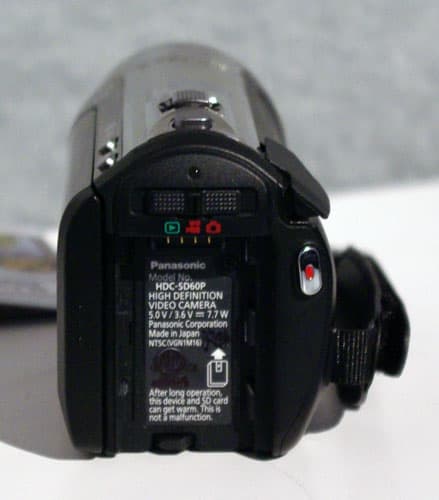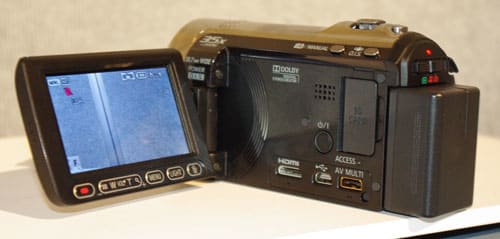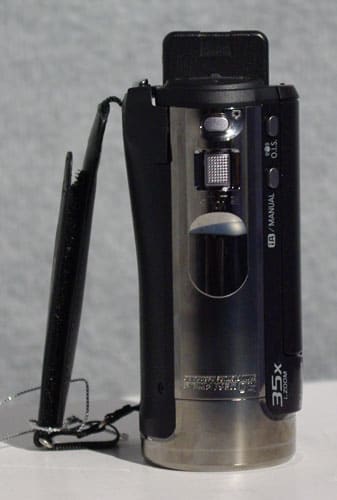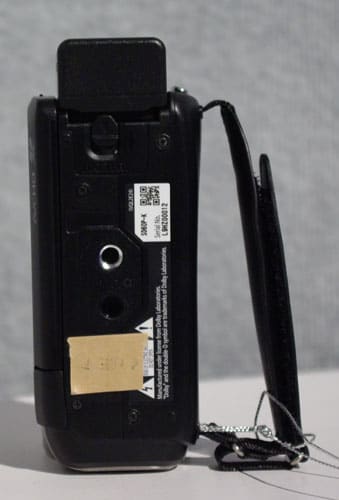Product Tour
The HDC-SD60 has most of the same features as Panasonic's mid-range HD models from last year, but Panasonic has done a lot of tinkering under the hood. The SD60 has a new 1/4.1-inch CMOS sensor and it is equipped with a 25x optical zoom lens—both significant improvements over last year's models.
The HDC-SD60 looks pretty standard from the front, although the new LED video light worked surprisingly well. There's also a built-in flash above the lens and a built-in speaker below. The new wide-angle, 25x optical zoom lens is quite impressive for a mid-range HD camcorder.
The right side of the camcorder is mostly plastic, but it does have a comfortable, textured feel. The DC port is also rather hidden at the top left and is covered by a plastic protector.

The battery pack loads in the back of the camcorder.
On the back of the camcorder is the battery compartment, a mode dial switch, and the start/stop record button.

The HDC-SD60 isn't overly populated with buttons.
Inside the LCD cavity are a number of ports—HDMI terminal, USB port, and the AV-multi connector (works with Panasonic's combo AV and Component cable). The SD/SDHC/SDXC card slot is also located inside the LCD cavity along with the power button. The 2.7-inch LCD flips out on the left side and has a number of buttons on the base of the panel.

The top of the HDC-SD60 has a few controls.
The top of the camcorder has the zoom toggle, photo shutter button, and a grooved area to place your fingertips. There are also two small buttons—the OIS (image stabilization) and iA/Manual button—on the top side of the camcorder.

*The bottom has a tripod mount and battery release.
*
Compression & Media
Panasonic didn't really change anything with the compression system on its 2010 camcorders. These new HD models still use AVCHD compression, which is built on the MPEG-4 AVC/H.264 codec. Panasonic also didn't increase the maximum bitrate for recording video with these new HD camcorders. They all still top out with a bitrate of 17Mbps—which is significantly lower than the 24Mbps ceiling offered by AVCHD. Both Canon and JVC have 24Mbps settings on their consumer camcorders.
The HDC-SD60 is a card-only camcorder, which means it contains no internal memory. The model is, however, compatible with SDXC memory cards as well as SD/SDHC cards. SDXC cards offer higher capacity than SDHC and there are a few 64GB cards in the works from various manufacturers—including Panasonic itself. All of Panasonic's 2010 models are compatible with SDXC memory cards (as well as SD and SDHC cards).
The three HD camcorders announced by Panasonic at CES each have different media options. As we mentioned, the HDC-SD60 is card-only, while the HDC-HS60 has a 120GB internal hard drive (in addition to its memory card slot). If you want to stick with flash memory, Panasonic has the twin memory HDC-TM55. The TM55 has 8GB of internal flash memory along with its card slot.
Panasonic doesn't include a brand new software package with the HDC-SD60. Instead, the camcorder ships with an updated version of HD Writer AE (this year its version 2.0). The 1.5 version of the software was decent enough for importing your footage, but we won't know what kind of updates have been made to the program until we get a copy of the new version to try out.
Since the HDC-SD60 records AVCHD video, the camcorder must come with the caveat that you'll need a very powerful computer to work with the footage. AVCHD files can take forever to import if you have a slow computer—and they can take a long time on decent computers as well. If you plan on doing extensive editing with AVCHD footage, make sure you have a computer (and enough hard drive space) that is up to the challenge.
Manual Controls
In our brief time with the HDC-SD60 we didn't notice any striking differences with its auto controls as compared to last year. Panasonic's Intelligent Auto (iA) functions worked quite well and the AF/AE tracking feature is still a strong feature for the model.
The face detection feature on the HDC-SD60 has been updated with new auto shutter controls that will automatically snap a photo when it detects a smiling subject within the frame. This feature is similar to the smile shutter setting on numerous Sony camcorders.
Low Light Modes
We couldn't find the Magic Pix setting that was Panasonic's low light mode of yore, but the SD60 does have a Color Night Record mode that appears to be exactly the same thing. Color Night Record lets the camcorder use very slow shutter speeds and probably boosts the gain to its maximum level so you can shoot in low light situations, albeit with lots of motion trailing from the slow shutter.
Scene Modes
The SD60 appears to have the same set of scene modes as last year's camcorders, but it was difficult to tell due to Panasonic's inscrutable icons for its scene modes. Instead of saying what each scene mode is useful for in text, the camcorder shows confusing icons that can be difficult to decipher.
The zoom toggle on the HDC-SD60 is top-mounted and isn't much different than last year's models. There's also the zoom buttons on the base of the LCD panel, but they don't work all that well (and they aren't comfortable to press).
The HDC-SD60 has an optical zoom of 25x, which is very good for an HD camcorder. It is also a big improvement over last year's models from Panasonic, as they only had 16x optical zoom lenses. The zoom can be expanded to 35x using Panasonic's Intelligent Zoom setting. Intelligent zoom is different than digital zoom in that it doesn't result in much image degradation when utilized. The intelligent zoom system attempts to enhance the image to make it look sharper and clearer than a regular digital zoom.
Focus is adjusted using the touchscreen system on the HDC-SD60 and it isn't really improved from last year's mid-range HD models from Panasonic. In fact, all of these manual controls are essentially unchanged from last year's HDC-SD20 camcorder.
Exposure is adjustable on the HDC-SD60, but it is buried deep in the camcorder's menu under the picture adjustment heading. Panasonic did remove a few of the extra info screens that you must tap your way through before you can actually adjust the exposure, however, so there has been some improvement. Good job Panasonic!
Aperture is part of the function menu with the HDC-SD60, just like it was on previous models. Panasonic calls aperture adjustment iris, and the control is still tied to gain. Only after the aperture is fully open (to f/1.8) can you adjust the gain settings.
Shutter speed is set just like aperture on the SD60. It is part of the camcorder's function menu and it is adjusted using by tapping buttons on the touchscreen display. The lowest available shutter speed you can set manually is 1/30 of a second, but you must turn on auto slow shutter for that option (otherwise 1/60 is the lowest available).
Panasonic didn't change anything with its white balance settings on the HDC-SD60. The camcorder has a few white balance presets and a custom option that is easy to set. In the picture adjustment settings you can also adjust the color temperature on the camcorder manually. The setting allows you to push the color temperature red or blue.
Gain can only be set on the HDC-SD60 when the aperture is fully opened on the camcorder. We'd like to see Panasonic separate aperture and gain control on its camcorders, but it doesn't seem like this will happen anytime soon.
Nothing really new here for Panasonic this year. The camcorder still has a tele macro setting and guide lines for framing assist, but nothing really jumped out as a new feature for 2010. The SD60 does feature an improved stabilization system, however, and we discuss that in the Handling section of this review.
Still Features
Since the HDC-SD60 has a larger sensor than Panasonic's previous mid-range HD camcorders, this means it also has better still image capabilities. The camcorder can take up to 5-megapixel photos, but its maximum native resolution is around 2-megapixels for photos (its effective pixel count for stills is 2.32-megapixels, to be precise). Even though this is a far cry from what many high-end camcorders (not to mention dedicated digital cameras) are capable of, this represents quite an improvement from last year.
The camcorder also can take photos at three different aspect ratios—4:3, 3:2, or 16:9. A complete list of the camcorder's photo size options is in the table below. When looking at this list, however, remember that the highest native resolution for the camcorder is 1920 x 1080. The higher resolution photos are all interpolated.
In addition to adding all these photo settings, Panasonic also implemented a smile shutter feature that is similar to what Sony has on its new camcorders. Smile shutter will automatically take a photo when the camcorder recognizes a smiling face within the frame. This feature will even work while you are recording video—with the camcorder continuing to record video during and after the photo is taken.
Handling & Use
The HDC-SD60 seems to be just as easy to use as Panasonic's 2009 mid-range HD models. The camcorder's touchscreen is simple to understand—although it can be annoying to use for adjusting manual controls—and the menu system is easy to navigate. We also found the size of the SD60 to be a good sweet spot for a compact camcorder. It isn't so small that it feels awkward in your hand, but it's also still small enough to be considered compact. Panasonic's iA controls are just as good as they were last year, and the new smile detection settings are a fun addition.
We still don't love the touchscreen system on the SD60 for manipulating manual controls. The touchscreen can be finicky, and using the touch buttons do set focus, shutter speed, or aperture can be difficult. So, if you want a camcorder that is easy to control manually you should definitely look elsewhere.
We liked the way the HDC-SD60 felt in our hand very much. The right side of the camcorder was definitely comfortable with its rounded shape and the hand strap was adequate. The strap didn't have as much padding as what you get on most high-end models, but it worked for a camcorder of the SD60's size. We found the SD60 to be significantly more comfortable in our hand than its sister-model the HDC-HS60. The HS60, of course, has its 120GB internal hard drive taking up space and making the right side of the camcorder boxier—and, subsequently, less comfortable.
One of the most important new features on the HDC-SD60 is the enhancements to optical image stabilization (OIS) that Panasonic has made. The SD60 features regular OIS, Advanced OIS (this was on some of Panasonic's camcorders last year), and a brand new Powered OIS feature. The Powered OIS is specifically meant for stabilizing images with lots of zoom or in situations that have lots of shake. We didn't get to perform our lab test on the HDC-SD60 while we were at CES, but we are very excited about testing this new OIS system. Other manufacturers have also rolled out new stabilization systems in 2010, so it will be very interesting to see who performs the best in our testing.
The HDC-SD60 definitely isn't the most portable Full HD camcorder you can find, but Panasonic did slim down the model a tiny bit compared to last year. The SD60 weighs roughly 255g without its battery, which is around 15g lighter than last year's SD20. All of Panasonic's 2010 models are still too large to transport in your pocket with utmost comfort, but they'll probably fit into a loose pocket if you force them.
We would have liked to see Panasonic shave even more weight off of these new camcorders, but the size of the HDC-SD60 is understandable. Panasonic increased the sensor size and optical zoom on the HDC-SD60 (compared to last year), yet still managed to make a lighter camcorder. When it comes down to it, that's a pretty resourceful feat.
The HDC-SD60 has a rear-mounted battery compartment. The compartment isn't enclosed, which means the camcorder can easily accommodate larger, longer-lasting battery packs. Panasonic also put the DC-input on the side of the camcorder with the HDC-SD60, which we're rather happy about. We have never liked it when Panasonic put the DC-input inside the battery compartment, which they did on a number of previous models.
There's nothing new to report about the LCD on the HDC-SD60. It's the same 2.7-inch screen with a 230,400-pixel resolution that was featured on most of Panasonic's models from last year. The LCD uses touchscreen technology that is integral for working with some of Panasonic's Intelligent Auto (iA) controls. The AF/AE tracking feature, for example, requires you to touch a subject on the screen that you want to track, focus, and expose properly as it moves about the frame.
The HDC-SD60 has no electronic viewfinder, which is also the case with the rest of Panasonic's mid-range HD lineup. Only Panasonic's high-end HD models—which they have yet to announce for 2010—feature viewfinders.
The menus on the HDC-SD60 have the same design as last year's models, although some of the features and settings have been switched around. You still shuffle through the menus using the touchscreen buttons, which can be something of a nuisance considering the screen isn't all that large. Still, the menu system is easy to figure out and many first-time users like the simplicity of an LCD touchscreen.
The menu has an information box that can be selected if you want the camcorder to give you more info about each option you select. With the info box turned on it definitely takes a lot longer to navigate the menus (a box pops up each time you select something), but it's a helpful tool for figuring out the camcorder.
For setting manual controls like focus, shutter speed, and aperture, you must use the camcorder's Function menu. This is the little on-screen menu that appears when you tap the 'F' in the lower left corner of the LCD. The Function menu has a few more controls than last year, but the idea behind it is exactly the same. We're still not crazy about using the function menu—we'd much rather have a control ring or dial—but it's not that bad.
Playback & Connectivity
We didn't notice any new playback features for the HDC-SD60. The camcorder has a dedicated playback mode, which you can get to by flicking the mode switch on the back of the camcorder. You select clips for playback by tapping on them (on the LCD) and the VCR controls all exist as touchscreen buttons. As we said in other parts of this review, the touchscreen button system isn't great, but it is workable.
The HDC-SD60 doesn't have tons of ports, but it does have all the basics. The HDMI terminal, USB port, and AV-multi port are all located inside the LCD cavity. Unfortunately, these ports are not protected by a cover, but the LCD does protect them decently when it is closed. The AV multi terminal allows for AV-out and Component-out connections using Panasonic's proprietary cable.
On the right side of the camcorder is the DC-input, which has a regular-fit design. This terminal takes a 5.0-volt DC input and the port is protected nicely by a plastic cover. The camcorder does not have an accessory shoe, nor does it have an external microphone or headphone jack.
Rounding out the connectivity features is the camcorder's memory card slot. Since all video is recorded to memory cards on the HDC-SD60, this may actually be the camcorder's most important connectivity feature. The card slot is protected well by a rubberized cover that swings open.
The table below lists all the connectivity features on the HDC-SD60:
Audio & Other Features
The HDC-SD60 has a front-mounted microphone that records Dolby Digital 2-channel audio. The built-in microphone has zoom mic capability, which allows the audio recording to focus on whatever the camcorder is zoomed into. Panasonic also improved its Wind Cut feature and now offers an entirely new setting called Wind Noise canceller. Wind Noise canceller should be more effective in reducing wind noise because it uses a noise canceling system—much like what is found on noise canceling headphones. The previous Wind Cut feature simply used a high-pass audio filter to reduce wind noise.
The HDC-SD60 doesn't have any audio connectivity features. It has no external mic port, no headphone jack, and no accessory shoe. It does have a number of manual audio modes, including a mic attenuator and audio level controls.
Video Light
The Panasonic HDC-SD60 features an LED video light. We couldn't really test the light too extensively, so we're not sure if it represents much of an improvement over the light on last year's HDC-SD10.
Conclusion
Photo Gallery
Specs
{{manufacturer_specs_table}}{{raw_scores_table}}
Meet the tester
Jeremy is the video expert of our imaging team and Reviewed.com's head of video production. Originally from Pennsylvania and upstate NY, he graduated from Bard college with a degree in film and electronic media. He has been living and working in New England since 2005.
Checking our work.
Our team is here for one purpose: to help you buy the best stuff and love what you own. Our writers, editors, and lab technicians obsess over the products we cover to make sure you're confident and satisfied. Have a different opinion about something we recommend? Email us and we'll compare notes.
Shoot us an email
